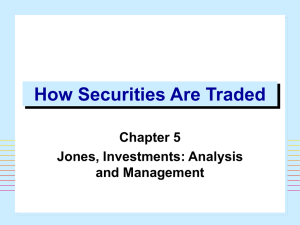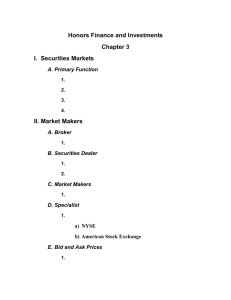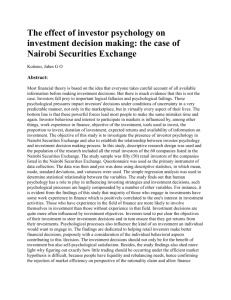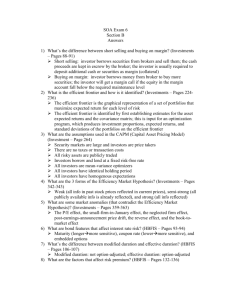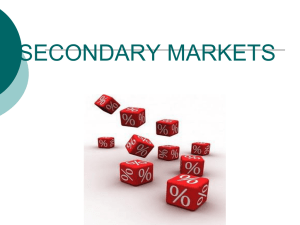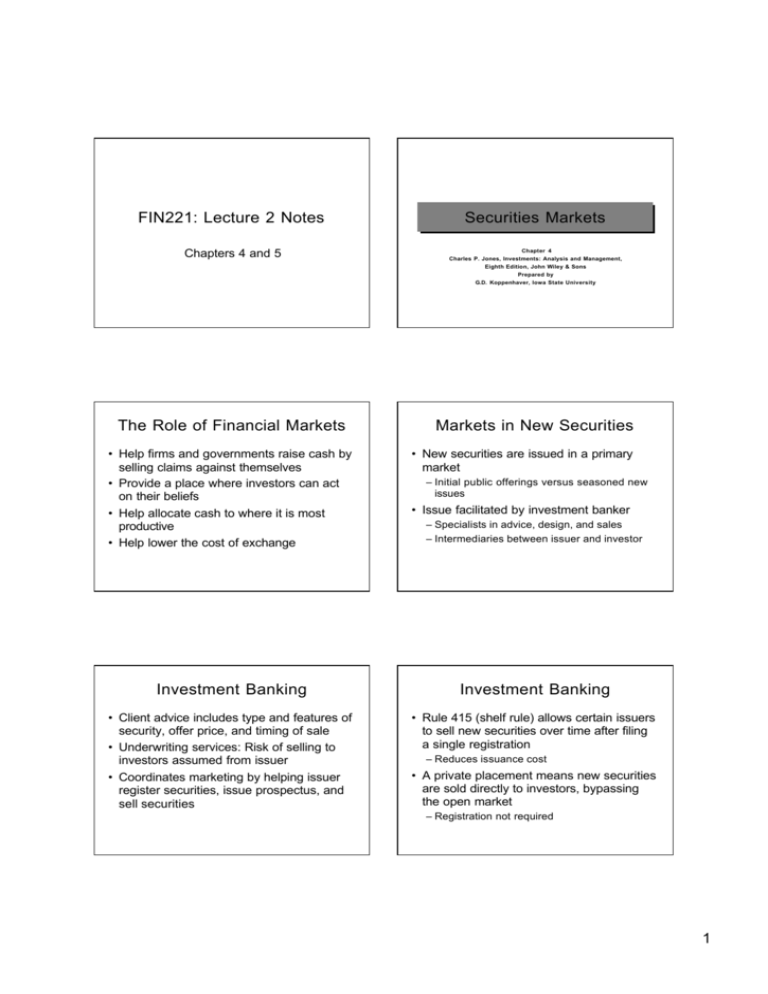
FIN221: Lecture 2 Notes
Securities Markets
Chapters 4 and 5
Chapter 4
Charles P. Jones, Investments: Analysis and Management,
Eighth Edition, John Wiley & Sons
Prepared by
G.D. Koppenhaver, Iowa State University
The Role of Financial Markets
Markets in New Securities
• Help firms and governments raise cash by
selling claims against themselves
• Provide a place where investors can act
on their beliefs
• Help allocate cash to where it is most
productive
• Help lower the cost of exchange
• New securities are issued in a primary
market
– Initial public offerings versus seasoned new
issues
• Issue facilitated by investment banker
– Specialists in advice, design, and sales
– Intermediaries between issuer and investor
Investment Banking
Investment Banking
• Client advice includes type and features of
security, offer price, and timing of sale
• Underwriting services: Risk of selling to
investors assumed from issuer
• Coordinates marketing by helping issuer
register securities, issue prospectus, and
sell securities
• Rule 415 (shelf rule) allows certain issuers
to sell new securities over time after filing
a single registration
– Reduces issuance cost
• A private placement means new securities
are sold directly to investors, bypassing
the open market
– Registration not required
1
Secondary Markets
• Markets where investors trade previously
issued securities
• Auction markets involve bidding in a
specific physical location
– Brokers represent investors for a fee
– Others trade for their own account
• Negotiated markets consist of
decentralized dealer network
Over-the-counter Markets
• Network of dealers standing ready to
either buy or sell securities at specified
prices
– Dealers profit from spread between buy and
sell prices
– Handle unlisted securities
• NASDAQ: Competing dealers make
markets in OTC stocks
Foreign Markets
• US equity markets account for a third of
world’s stock market capitalization
– Many different equity markets exist
• Emerging market: Stable political system,
low regulation, low standardization in
trading activity
– Risks: Illiquidity, lack of information, political
uncertainty
Stock Exchanges
• NYSE is a secondary, auction market in
equity shares
– Not-for-profit organization of members
– Listing requirements for traded firms
– “Specialists” assigned to each traded equity to
make a market in that stock
• AMEX and regional exchanges list smaller
firms, have less volume than NYSE
Third and Fourth Markets
• Third Market: Over-the-counter
transactions in securities listed on
organized exchanges
• Fourth market: Trading network among
investors interested in buying and selling
large blocks of stock
– Brokers, dealers bypassed so costs low
– Electronic or telephone network
Equity Market Indicators
• Provide a composite report of market
behavior on a given day
• Dow Jones Industrial Average
– Composed of 30 “blue-chip” stocks
– Price-weighted index: Essentially adds the
prices of 30 stocks, divides by 30
• Adjusted for stock splits, stock dividends
– Oldest, most well-known measure
2
Equity Market Indicators
• Standard & Poor’s Composite Index
– Composed of 500 “large” firm stocks
– Expressed as index number relative to a base
index value of 10 (1941-43)
– Value-weighted index: Prices and shares
outstanding considered
Equity Market Indicators
• NYSE and NASDAQ Composite Indices
– Value-weighted indices of broad markets
• Nikkei 225 Average
– Price-weighted index of 225 actively -traded
stocks on the Tokyo Stock Exchange
• Indicates how much the average equity value of
the 500 firms in the index has increased relative to
the base period
Bond Markets
• Secondary bond market is primarily an
over-the-counter network of dealers
– NYSE features an automated bond system to
execute orders.
• Mostly corporate bonds, thinly traded
– Treasury and agency bonds actively trade in
dealer markets
• Municipal bonds less actively traded
Copyright © 2002 John Wiley & Sons, Inc. All rights reserved.
Reproduction or translation of this work beyond that permitted
in Section 117 of the 1976 United States Copyright Act
without the express written permission of the copyright owner
is unlawful. Request for further information should be
addressed to the Permissions Department, John Wiley &
Sons, Inc. The purchaser may make back-up copies for
his/her own use only and not for distribution or resale. The
Publisher assumes no responsibility for errors, omissions, or
damages, caused by use of these programs or from the use
of the information contained herein.
Market Developments
• Growth of institutional trading associated
with:
– Block trading of stocks (transactions of at
least 10,000 shares)
• Affects market structure and operation
– Negotiated, not fixed, commissions
• Evolution of National Market System
– Centralized system for price and activity
reporting, order routing and sequencing
How Securities Are Traded
Chapter 5
Charles P. Jones, Investments: Analysis and Management,
Eighth Edition, John Wiley & Sons
Prepared by
G.D. Koppenhaver, Iowa State University
3
Brokerage Operations
• Brokerage firms earn commissions on
executed trades, sales loads on mutual
funds, profits from securities sold from
inventory, underwriting fees and
administrative account fees
– Full-service brokers offer order execution,
information on markets and firms, and
investment advice
– Discount brokers offer order execution
Account Types
• Cash management account
– Checks can be written against account’s
assets
– Instant loans at a markup to call money rate
based on the account’s assets
• Wrap account: Brokers match investors
with outside money managers
– All costs, fees wrapped into one
Orders in Auction Markets
• Most NYSE volume from matched public
buy and sell orders
• Specialists act as both brokers and
dealers in the stocks assigned to them
– Maintain the limit order book
– Keep a fair and orderly market by providing
liquidity
Account Types
• Cash account: Investor pays 100% of
purchase price for securities
• Margin account: Investor borrows part of
the purchase price from the broker
• Asset management account: automatic
reinvestment of excess cash balances in
money market fund
Fees and Costs
• Brokerage commissions differ by security,
broker, and investor
– Institutional investors have greatest
negotiating power
• Dividend reinvestment plans permit
reinvestment of dividends in additional
stock
– Avoids commissions, administrative fees
NYSE Automation
• SuperDot: An electronic order recording,
reporting, routing, and matching system
– Specialist’s Electronic Book records and
reports limit and market orders
– Preopening buy and sell orders matched and
imbalance reported to specialist
– Members send orders directly to specialist for
execution and confirmation
4
Orders in OTC Markets
• Dealers ready to either buy or sell
– Bid price is highest offer price to buy
– Ask price is lowest price willing to sell
• Ask price - Bid price >0 (dealer spread)
– “Makes a market” in the security
– More than one dealer for each security in
over-the-counter markets
Settlement
• Most settlement dates are three business
days after the trade date
– Legal ownership transferred and financial
arrangements settled with brokerage firm
– Book-entry system reduces costs
• Transfer of securities and funds between
exchange members facilitated by a
clearinghouse
Regulation
• Stock exchanges are also self-regulated
Types of Orders
• Market orders: Authorizes immediate
transaction at best available price
• Limit orders: Specifies a particular market
price before a transaction is authorized
• Stop orders: Specifies a particular market
price at which a market order is authorized
Regulation
• SEC Act of 1934 created the Securities
and Exchange Commission
– Administers all securities law
– Monitors public securities transactions
• Requires issuer registration for public offers
• Investigates indications of violations such as
“insider trading”
• Securities Investor Protection Act of 1970:
insures accounts
Margin Accounts
– In own self -interest to regulate and monitor
member behavior
– NYSE “circuit-breakers” attempt to reduce
volatility
• To open margin account, exchanges set
minimum required deposit of cash or
securities
• Investor then pays part of investment cost,
borrows remainder from broker
• NASD: Trade association that regulates
OTC brokers and dealers
– Margin is percent of total value that cannot be
borrowed from broker
• Cash: 100% loan value; securities: 50%
5
Margin Accounts
• Federal Reserve sets the minimum initial
margin on securities
– Unchanged since 1974 at 50%
• Actual margin at any time cannot go below
the maintenance margin level set by
exchanges, brokers
– Investor’s equity changes with price
– Margin call when equity below maintenance
level
Short Selling
• Investor borrows stock from broker or held
in “street name” accounts
• Borrowed security sold in open market, to
be repurchased later at an expected price
lower than sale price
– Investor liable for declared dividends
– Short sale proceeds held by broker
– Demand loan of stock
6

